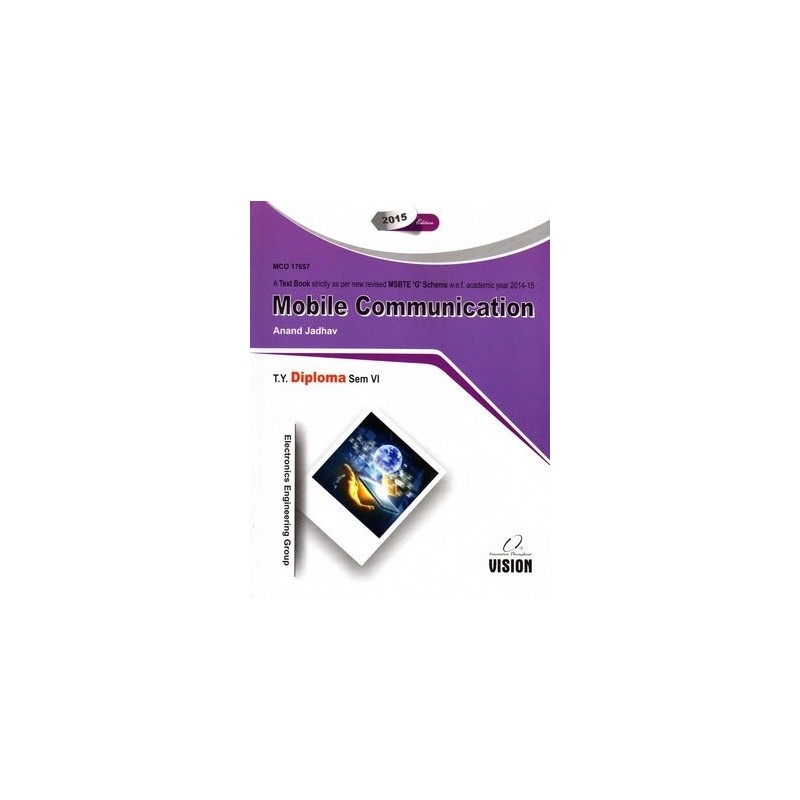Email: tovisionpune@gmail.com



Author: Anand Jadhav
Book ID: 1637
ISBN: 978-93-5016-308-5
CONTENTS
1. Introduction to Wireless Communication System
1. Introduction
2. Evolution of Mobile Radio Communications (2G, 2.5G and 3G Wireless System)
3. Mobile Radio System Around the World (AMPS, IS 95, GSM, N – AMPS)
3.1 AMPS
3.2 IS 95
3.3 GSM (Global System for Mobile Communication)
3.4 Narrowband AMPS (N-AMPS)
4. Applications of Wireless Communication Systems
4.1 Paging System
4.2 Cordless Telephone System
4.3 Cellular Telephone System
5. Mobile Unit
5.1 Block Diagram and Operation of Mobile Unit
5.2 Transmitter of Mobile Unit
5.3 Receiver of Mobile Unit
5.4 Frequency Synthesizer
5.5 Logic Unit and Control Unit
5.6 Essential Features of Hand Set
2. The Cellular Concept
1. Introduction
2. Frequency Reuse Concept
3. Multiple Access Technologies for Cellular Systems
3.1 Frequency Division Multiple Access (FDMA)
3.2 Time Division Multiple Access (TDMA)
3.3 Code Division Multiple Access (CDMA)
4. Cellular System Operation and Planning Principles
4.1 Cellular Operation System
4.2 Planning Principles
5. System Architecture
6. Mobility Management
6.1 Location Updating and Call Setup
6.2 Hand off Strategies and Power Control
7. Interference and System Capacity
7.1 Co-Channel Interference and System Capacity
7.2 Channel Planning for Wireless System
7.3 Adjacent Channel Interference
7.4 Improving Coverage and Capacity in Cellular System
3. Digital Cellular Mobile System
1. Introduction
2. Global System for Mobile Communication (GSM)
2.1 Concept of GSM
2.2 GSM Standardization and Service Aspects
2.3 GSM Architecture
2.4 GSM Radio Aspects
2.5 Security Aspects
2.6 GSM Protocol Model
2.7 Typical Flow Sequence in GSM
3. IS-95 (Interim Standard-95)
3.1 Concept of IS 95
3.2 Service Aspects
3.3 Network Reference Model
3.4 Security Aspects
3.5 Radio Aspects
3.6 Key Features of IS 95 CDMA Systems
3.6 Forward Traffic Channel
3.7 Reverse Traffic Channel
4. Signal System No. 7 (SS7)
4.1 Concept of SS7
4.2 Network Service Part (NSP) of SS7
4.3 Signalling Traffic in SS729
4.4 Signaling Points in SS-7
4.5 SS7 Services and Performance
4. Modern Wireless Communication System
1. Introduction
2. Evolution for 2.5 G TDMA Standards
2.1 HSCSD for 2.5 G GSM
2.2 GPRS for 2.5 G GSM and IS-136
2.3 EDGE for 2.5G GSM and IS-136
2.4 IS-95B for 2.5 G CDMA
3. IMT 2000
3.1 IMT 2000 Vision
3.2 Radio Spectrum for IMT-2000
5. Modern Wireless Networks
1. Introduction
2. Third Generation (3G) Wireless Networks
2.1 3G W-CDMA Universal Mobile Telecommunication System (UMTS)
2.2 WCDMA Protocol Architecture
2.3 WCDMA Network Architecture
2.4 3G CDMA 2000
2.5 Power Control in 3G CDMA 2000
2.6 3G-TD-SCDMA (Synchronous)
2.7 Wireless Local Loop (WLL)
2.8 LMDS (Local Multipoint Distribution Service)
3. Wireless Local Area Networks
3.1 Personal Area Networks (PANS)
3.2 Features of Bluetooth
3.3 Concept of AD HOC Mobile Communication for 4G and 4.5G
3.4 4G Wireless Architecture and Capabilities, Characteristics
3.5 MANET Applications
3.6 Blockage
3.7 Dropped Calls
3.8 Word Error Rate (WER)
3.9 Voice Quality